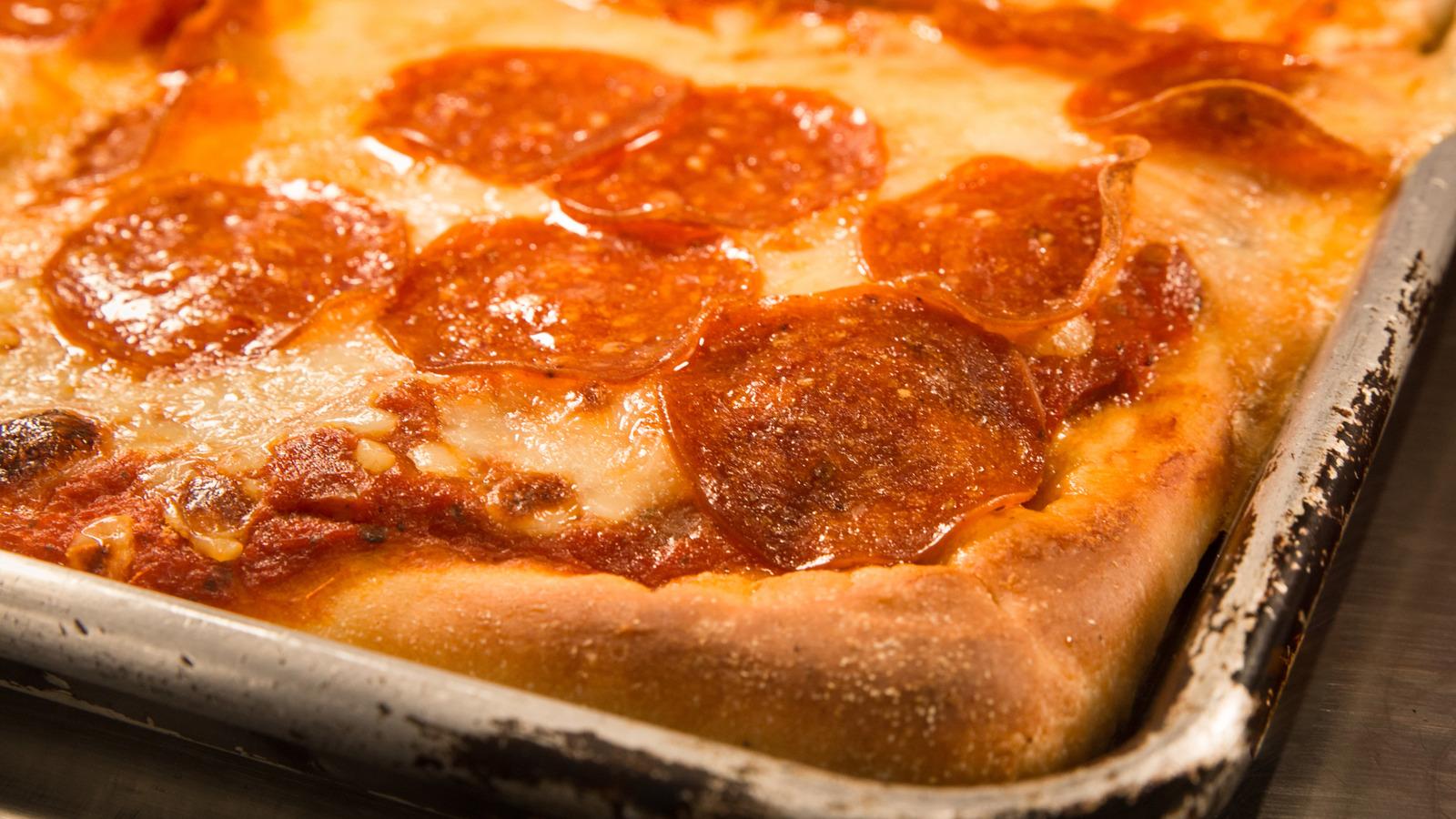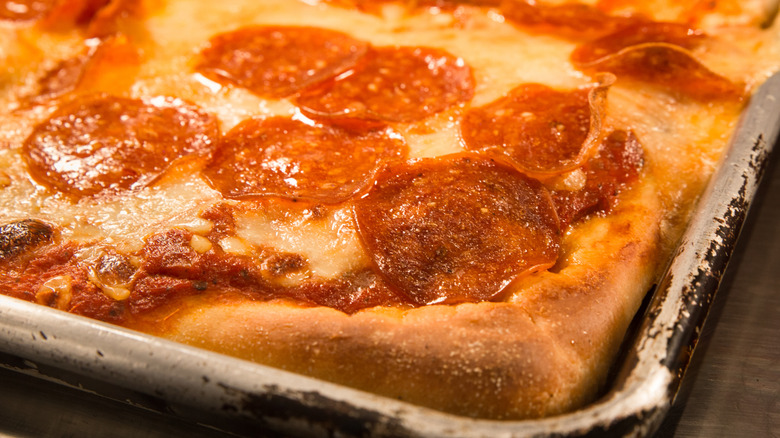
Littleny/Getty Images
Pizza is one of the most popular foods in America, and for good reason, as it's pretty hard to make a bad one. What makes a truly good pizza, however, is subjective, and a question that different regions of the United States — and the world — have different answers to. What makes a good pizza in New York City is not necessarily what makes a good pizza in Chicago, or St. Louis. There are nearly as many different styles of pizza in America as there are calories in a Hawaiian pizza. (Fun fact: Hawaiian pizza was actually invented in Canada.) And each has its own legion of supporters and defenders.
That's how it used to be, at least. But, as pizza chains have expanded across the country, things have become homogenized — and we're not just talking about the cheese. Some regional styles, like New York thin crust and Chicago deep dish, have spread to become national styles, while others have slowly faded in popularity, becoming harder and harder to find as tastes change.
Which beloved pizza styles from yesteryear are on the endangered pizza list? Which of those deserve a second chance, and which ones have overstayed their welcome? We'll answer those questions and more with a look at some styles that once claimed a pizza your heart.
Neapolitan
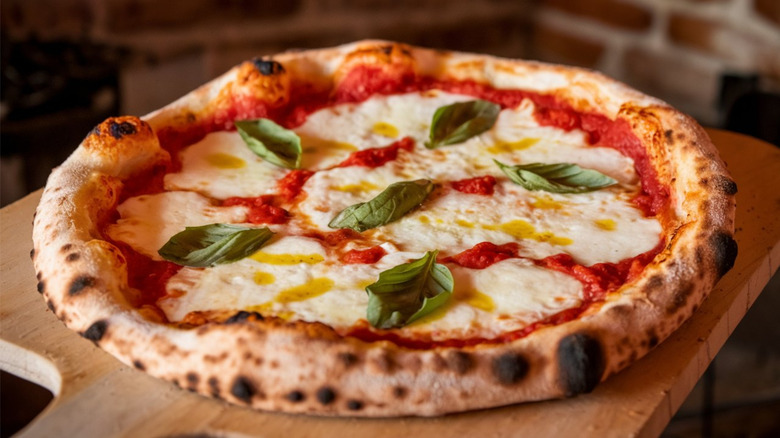
Food Arena/Shutterstock
In 2023, The Washington Post published a study of America's pizza predilections, revealing that the second-most popular style of pizza in the nation is something called "Neapolitan-ish." But that "-ish" is doing a lot of the heavy lifting, as true Neapolitan pizzas are being pushed aside by Americanized variations.
True Neapolitan pizzas have to abide by strict guidelines to be considered Neapolitan. In fact, there's an organization called Associazione Vera Pizza Napoletana, or The True Neapolitan Pizza Association, which regulates the making of Neapolitan pizzas. According to its rules, to qualify as a true Neapolitan pizza, the dough must be made with special flour from Naples, along with brewer's yeast. This should be kneaded and shaped by hand, and topped with specific ingredients, including San Marzano tomatoes. Finally, to get the official stamp of approval, the pizza should be cooked in a brick oven at a temperature of over 800 degrees.
Frankly, it's a lot of hoops to jump through, and many modern pizzerias don't have the equipment — such as an oven that can meet these specifications — to comply, even if they want to. That challenge has led to experimentation with hybrid styles, or Neapolitan-ish pizzas made in different ways, with different ingredients and toppings. These "neo-Neapolitans" are increasingly popular, with Pizza Today reporting in 2025 that "NEOpolitan" has risen to become the ninth most popular pizza style in America, while traditional Neapolitan has dropped to sixth. If you like the classic, get it while you can.
California style
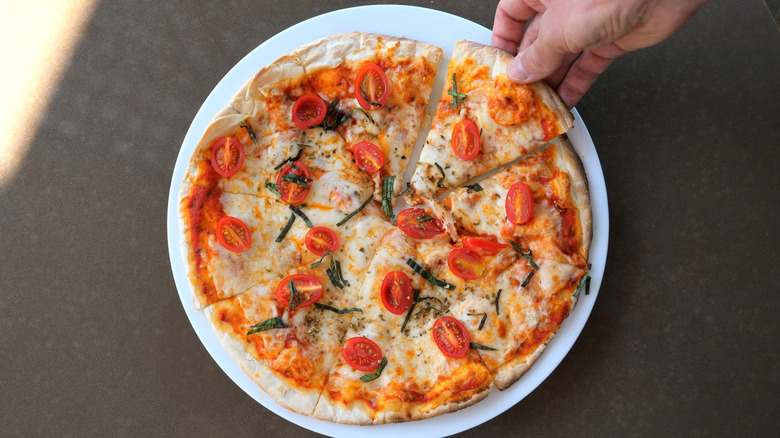
Molishka/Shutterstock
When the California style pizza debuted in the early '80s, it was a revelation. Where pizza once only had basic toppings (like pepperoni or anchovies) for basic people, California pizza introduced fancy gourmet toppings (like duck confit) for fancy people. Popularized nationwide by celebrity chef Wolfgang Puck, California style pizzas quickly became all the rage. Ingredients like cilantro, goat cheese, and roasted peppers on pizzas cooked in wood fire ovens were suddenly de rigueur.
In 1985, a couple of entrepreneurs jumped on the new pizza trend by creating a national chain called California Pizza Kitchen. It brought upscale pizzas to the heartland of America, and proved to be a massive hit — until it wasn't. In 2020, California Pizza Kitchen was hit hard by the COVID-19 pandemic, and was forced to declare bankruptcy, closing numerous locations as a result.
Though California Pizza Kitchen has since rebounded partially from its lowest point, the chain's struggles have made California style pizza harder to find. On the bright side, some of its innovations live on in other pizza styles: Barbecue chicken pizza, which was originally invented by California Pizza Kitchen, is now a mainstream choice for pizzas of all styles in America.
French bread pizza
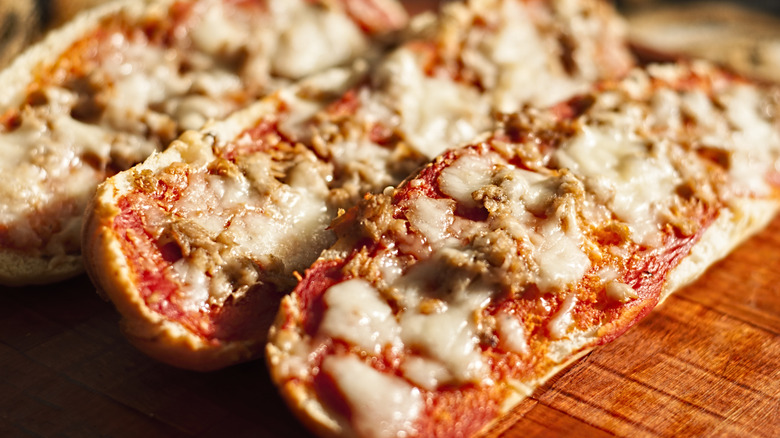
Sakari37/Getty Images
French bread pizza has long been a staple for kids who have access to a toaster oven, but not to actual pizza. Throwing tomato sauce and cheese onto some French bread, then toasting it up with any kind of toppings you want, is an easy 15-minute recipe for homemade pizza.
Those easy versions whipped up by innovative kids may have laid the groundwork for early frozen pizzas like Stouffer's French Bread Pizza, which made its debut in 1974. Stouffer's iconic snack was born of ingenuity, but also necessity. The company was looking for a way to optimize the production of its baguettes, and hit upon French bread pizza — the beloved do-it-yourself meal for latchkey kids in the 1980s and '90s — as the perfect solution.
Tastes change, and these days, there are far more frozen pizza options than ever before. Why settle for a cobbled-together approximation when you can buy something premade that's a lot more upscale, and ready in the same amount of time? That's presumably the line of thinking that led to the findings in evidnt's 2024 report on frozen pizza trends, which includes gourmet, health-focused, vegan, and plant-based options. Those who still want smaller, snack-sized pizzas are more likely to get pizza-adjacent bites, bits, and bobs like Totino's, or Hot Pockets. Meanwhile, Stouffer's no longer registers among the top six frozen pizza brands.
White pizza
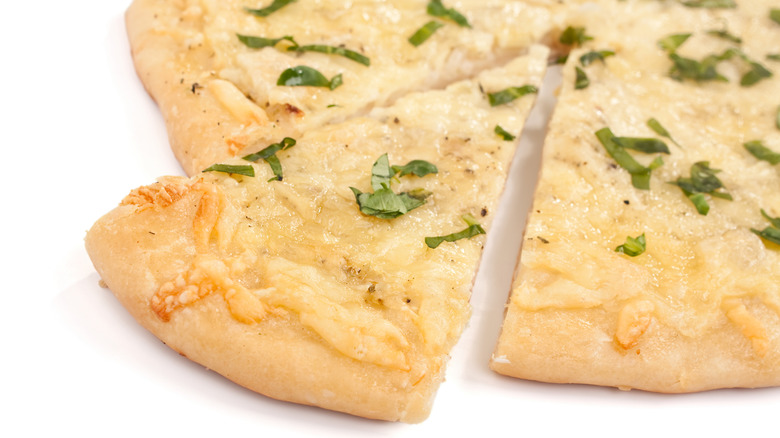
Olgna/Getty Images
White pizza, also known as pizza bianca, is actually the oldest form of pizza around. In its original form, white pizza is basically a flatbread with toppings, but (crucially) no tomato sauce. And this makes sense: Pizza bianca originated in Ancient Rome, more than a millennia before tomatoes were introduced to Europe in the 16th century.
In the United States, the gourmet, healthy pizza craze of the 1980s — which was sparked in part by the innovations of California style pizza — brought white pizza back to the forefront, but with a modern American twist. Instead of no sauce at all, these white pizzas often feature a "white" sauce like alfredo sauce, olive oil, or even clam sauce. But these newfangled additions come at a price: the supposed health benefits of white pizza. Today's white pizzas can be just as unhealthy as their red counterparts, due to the extra cheese or oil used instead of tomato sauce. So, unless you have a specific gastric problem that could be exacerbated by the acidity of tomato sauce, or you just don't like it, there's no reason to skip out on the taste. As more people wake up to that fact, white pizza seems to be slowly going the way of the Roman Empire. Et tu, bianca?
Colorado style
Also known as a "mountain pie," Colorado style pizza was first developed by restaurateur Chip Bair. In 1973, Bair bought a pizzeria called Beau Jo's in Idaho Springs, Colorado, and quickly innovated a new, sky-high style finished with a heaping "mountain" of toppings. The other defining trait of Colorado style pizza is its thick, braided crust, which is made with honey rather than sugar. At all Beau Jo's locations, you can order a side of honey to dip the crust into while you eat — what the local chain refers to as its signature "built-in dessert."
Early success prompted the expansion of Beau Jo's into a beloved Colorado franchise. But in recent years, that expansion has become a contraction, as increased competition has forced Beau Jo's to shrink and close some locations. According to The Washington Post, Colorado style isn't even the most popular style of pizza in Colorado: New York style, Neapolitan-ish, and Detroit style pizzas all rank higher among pizza aficionados in the Rocky Mountain State.
Will Colorado style pizza survive? Bair certainly hopes so. In 2023, after 50 years at the helm of Beau Jo's, Bair announced that he was selling the company to his employees in the hopes that they would keep the mountain pie's legacy going. "Now we will start teaching the employees what it means to be an owner," Bair told The Colorado Sun, "and hopefully that creates an atmosphere in the restaurant for pride, inclusion and people working together."
Greek style
Invented in the 1950s by Greek immigrants, Greek style pizza is not, in fact, characterized by Mediterranean toppings like feta or olives. Rather, the ways in which it differs from other styles are in the preparation and treatment of the dough. Greek style pizza is cooked in a pan, and it boasts a spongy crust akin to focaccia bread, but with a crunchy exterior thanks to the pan being oiled. The result is a unique regional style of pizza that still remains popular across New England, especially in Massachusetts and New Hampshire.
However, while Greek style pizza is a mainstay in New England, it is also under threat from invasive pizza species. New York style pizza is now the favorite style in several New England states,and New Haven style pizza — another Connecticut invention — is also spreading, with New Haven chains opening locations in the Boston area and beyond. Yet another challenge is one that many regional styles of pizzas face: pizza snobs looking down their nose at it. There's even a Vice article floating around that claims that no Greek style pizza ever made has risen above mediocrity.
Here's hoping that Greek style pizza sticks around. After all, with recent signs that Boston Market is struggling, the region can't afford to lose any more of its signature dining options.
Sicilian style
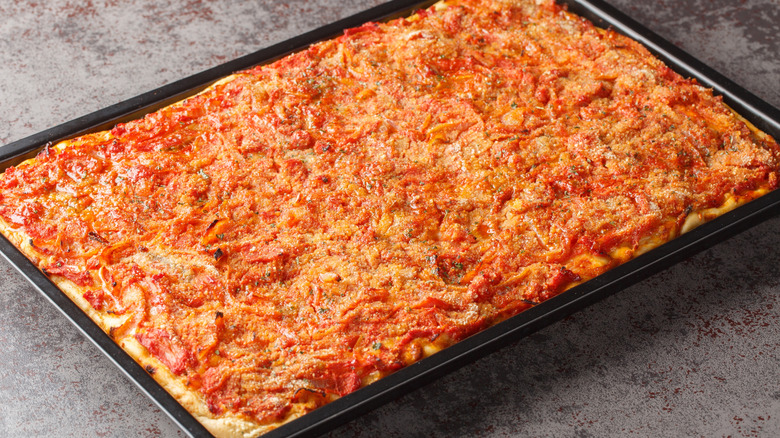
Sergii Koval/Shutterstock
Sicilian pizzas have a long and rich history. Invented in — you guessed it — Sicily, this style of pizza is characterized by its thick, rectangular crust, and bread-like consistency. Baked in a pan, Sicilian style pizzas were originally topped with breadcrumbs rather than cheese, but modern American versions usually include cheese.
While Sicilian style pizza remains well liked, it has become increasingly overshadowed by regional variations that have grown in popularity over the years. For example, on Long Island, a similar style called Grandma pizza is tops. Also baked in a rectangular pan, Grandma pizzas have a thinner crust, and the order of toppings is reversed, so the sauce goes on top of the cheese. That might sound like heresy, but not in Philly, where they take things a step further with the Tomato Pie, which forgoes cheese entirely, and is served cold rather than hot.
Even Detroit style pizza shares a lot of its DNA with Sicilian pizza. Thanks to national chains like Jet's Pizza and Little Caesar's, you can get Detroit style pizza across the country, while true Sicilian style pizza remains more of a specialty. And exposure matters. The Washington Post reported that Sicilian pizza is becoming less popular, an observation backed up by Pizza Today. But, who knows, maybe it will bounce back. After all, like they say in "The Princess Bride": Never go in against a Sicilian when death (or pizza) is on the line!
St. Louis style
Exactly what constitutes a St. Louis style pizza is a hot topic for debate in Missouri, even decades after the style first debuted there. All parties agree that St. Louis style pizzas have a thin, crunchy crust that feels closer to a cracker than it does to pizza dough. The debate, then, is whether or not a St. Louis style pizza needs specific toppings to qualify.
Fans of a local chain called Imo's swear by its use of something called Provel, which is a hybrid processed cheese kind of like Velveeta. Those who love it, love it. For instance, actor Jon Hamm is on record as being a big fan of Provel, and St. Louis style pizza. But it's safe to say that neither the cheese product, nor the style of pizza that enables it, is universally popular, even in St. Louis. As New York Times food writer Kenji López-Alt told KCUR: "It was funny because everybody thinks that their town has the best pizza, but St. Louis was the only town I've seen where there were equal parts, people who seemed to love it and people who kind of apologized for it."
Either way, the fiercely debated reliance on Provel cheese limits the style's range and scope. Though the cheese is still sold at Imo's, that's about the only place you can get it nowadays, putting the future of the entire style on very shaky footing.
Quad City style
Let's start with the obvious: Not only have most people never heard of Quad City style pizza, but many Americans have never even heard of the Quad Cities at all. Despite the name, there are actually five cities in the Quad City region: Davenport and Bettandorf in Iowa, and Rock Island, Moline, and East Moline in Illinois. These cities are arranged on opposing banks of the Mississippi River, but are united in their love of Quad City style pizza.
Well, "love" may actually be too strong a word for it, though the style certainly has its adherents, thanks to the pizza's unique crust (made with malt, and maybe molasses) and toppings (usually sausage, added before the cheese.) It sometimes has cayenne or cornmeal for extra flavor and texture, and is usually cooked in a rotating deck oven.
But while Quad City style pizza has been a mainstay of the region for decades, it's nearly impossible to get outside of the area. And even inside the area, its popularity seems to be on the wane. Chicago style pizza is actually the most popular type of pizza in both Illinois and Iowa, and when locals were asked on Quora about where to get the best pizza, the top answer wasn't any of the chains that serve Quad City style pizza; it was Costco. That's not exactly a ringing endorsement for this style's longevity.
Ohio Valley style
Of all the regional variants of pizza you can find in the United States, the Ohio Valley style is arguably the most unusual, in both cooking process and history. While some believe the myth that pizza was popularized in America by soldiers returning from World War II, in the case of Ohio Valley style pizza, they're right to do so. When Primo DiCarlo returned from his service in Italy to work at his parents' bakery, he raved about a dish he had eaten while stationed: pizza.
By the end of 1945, DiCarlo had opened a pizza shop — but his version of pizza was less an authentic Italian experience, and more a strange fever dream. After altering his parents' famous bread recipe to adapt it for use as pizza dough, Primo came up with the idea of adding most of the toppings after the dough was already baked. Yep, once the crust rises, a bit of sauce and cheese are added, and then the pie takes a second trip into the over. Once that's done, the rest of the toppings, including more cheese, are added to the pizza cold. That's right — cold.
Despite the practicality it offers food service professionals, this pizza style has drawn poor reviews from people who have tried it. While DiCarlo's descendants continue to uphold his unusual pizza making tradition, the fact that many people just fundamentally don't like it is a major roadblock to keeping that tradition alive.



